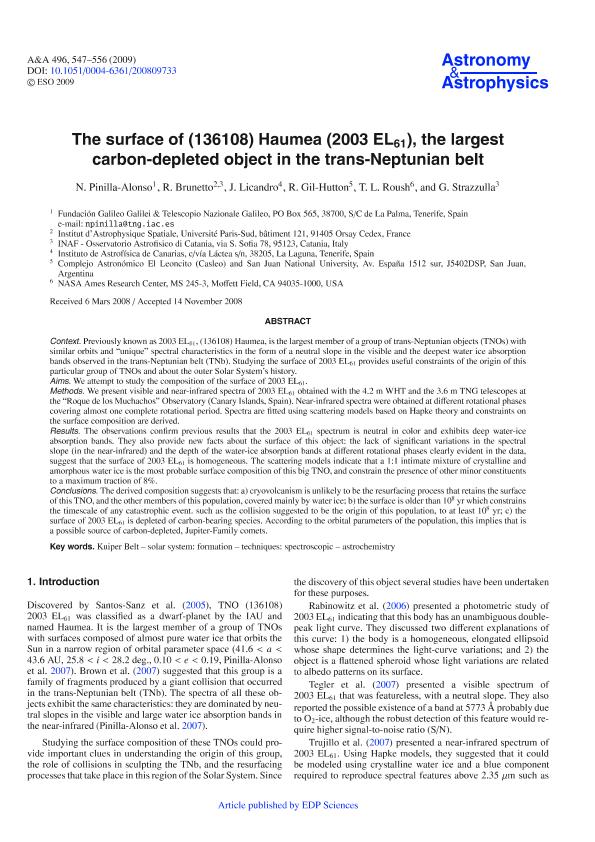Mostrar el registro sencillo del ítem
dc.contributor.author
Pinilla Alonso, N.
dc.contributor.author
Brunetto, R.
dc.contributor.author
Licandro, J.
dc.contributor.author
Gil Hutton, Ricardo Alfredo

dc.contributor.author
Roush, T.L.
dc.contributor.author
Strazzulla, G.
dc.date.available
2023-10-03T02:00:57Z
dc.date.issued
2009-03
dc.identifier.citation
Pinilla Alonso, N.; Brunetto, R.; Licandro, J.; Gil Hutton, Ricardo Alfredo; Roush, T.L.; et al.; Study of the surface of (136108) Haumea (2003 EL61), the largest carbon-depleted object in the trans-neptunian belt; EDP Sciences; Astronomy and Astrophysics; 496; 2; 3-2009; 547-556
dc.identifier.issn
0004-6361
dc.identifier.uri
http://hdl.handle.net/11336/213849
dc.description.abstract
Context Previously known as 2003 EL61, (136108) Haumea, is the largest member of a group of trans-Neptunian objects (TNOs) with similar orbits and "unique" spectral characteristics in the form of a neutral slope in the visible and the deepest water ice absorption bands observed in the trans-Neptunian belt (TNb). Studying the surface of 2003 EL61 provides useful constraints of the origin of this particular group of TNOs and about the outer Solar System's history. Alms. We attempt to study the composition of the surface of 2003 EL61. Methods. We present visible and near-infrared spectra of 2003 EL61 obtained with the 4.2 m. WHT and the 3.6 m TNG telescopes at the "Roque de los Muchachos" Observatory (Canary Islands, Spain). Near-infrared spectra were obtained at different rotational phases covering almost one complete rotational period. Spectra are fitted using scattering models based on Hapke theory and constraints on the surface composition are derived. Results. The observations confirm previous results that the 2003 EL61 spectrum is neutral in color and exhibits deep water-ice absorption bands. They also provide new facts about the surface of this object: the lack of significant variations in the spectral slope (in the near-infrared) and the depth of the water-ice absorption bands at different rotational phases clearly evident in the data, suggest that the surface of 2003 EL61 is homogeneous. The scattering models indicate that a 1:1 intimate mixture of crystalline and amorphous water ice is the most probable surface composition of this big TNO, and constrain the presence of other minor constituents to a maximum traction of 8%. Conclusions. The derived composition suggests that: a) cryovolcanism is unlikely to be the resurfacing process that retains the surface of this TNO, and the other members of this population, covered mainly by water ice; b) the surface is older than 10 8 yr which constrains the timescale of any catastrophic event, such as the collision suggested to be the origin of this population, to at least 108 yr; c) the surface of 2003 EL61 is depleted of carbon-bearing species. According to the orbital parameters of the population, this implies that is a possible source of carbon-depleted, Jupiter-Family comets.
dc.format
application/pdf
dc.language.iso
eng
dc.publisher
EDP Sciences

dc.rights
info:eu-repo/semantics/openAccess
dc.rights.uri
https://creativecommons.org/licenses/by-nc-sa/2.5/ar/
dc.subject
ASTROCHEMISTRY
dc.subject
KUIPER BELT
dc.subject
SOLAR SYSTEM: FORMATION
dc.subject
TECHNIQUES: SPECTROSCOPIC
dc.subject.classification
Astronomía

dc.subject.classification
Ciencias Físicas

dc.subject.classification
CIENCIAS NATURALES Y EXACTAS

dc.title
Study of the surface of (136108) Haumea (2003 EL61), the largest carbon-depleted object in the trans-neptunian belt
dc.type
info:eu-repo/semantics/article
dc.type
info:ar-repo/semantics/artículo
dc.type
info:eu-repo/semantics/publishedVersion
dc.date.updated
2023-07-07T20:32:33Z
dc.journal.volume
496
dc.journal.number
2
dc.journal.pagination
547-556
dc.journal.pais
Francia

dc.description.fil
Fil: Pinilla Alonso, N.. Fundación Galileo Galilei; España. Telescopio Nazionale Galileo; España
dc.description.fil
Fil: Brunetto, R.. Université Paris-Sud; Francia. Istituto Nazionale di Astrofisica; Italia
dc.description.fil
Fil: Licandro, J.. Instituto Astrofisico de Canarias; España
dc.description.fil
Fil: Gil Hutton, Ricardo Alfredo. Consejo Nacional de Investigaciones Científicas y Técnicas. Centro Científico Tecnológico Conicet - San Juan. Complejo Astronómico "El Leoncito". Universidad Nacional de Córdoba. Complejo Astronómico "El Leoncito". Universidad Nacional de la Plata. Complejo Astronómico "El Leoncito". Universidad Nacional de San Juan. Complejo Astronómico "El Leoncito"; Argentina
dc.description.fil
Fil: Roush, T.L.. National Aeronautics and Space Administration; Estados Unidos
dc.description.fil
Fil: Strazzulla, G.. Istituto Nazionale di Astrofisica; Italia
dc.journal.title
Astronomy and Astrophysics

dc.relation.alternativeid
info:eu-repo/semantics/altIdentifier/url/https://www.aanda.org/articles/aa/full_html/2009/11/aa09733-08/aa09733-08.html
dc.relation.alternativeid
info:eu-repo/semantics/altIdentifier/doi/http://dx.doi.org/10.1051/0004-6361/200809733
Archivos asociados
